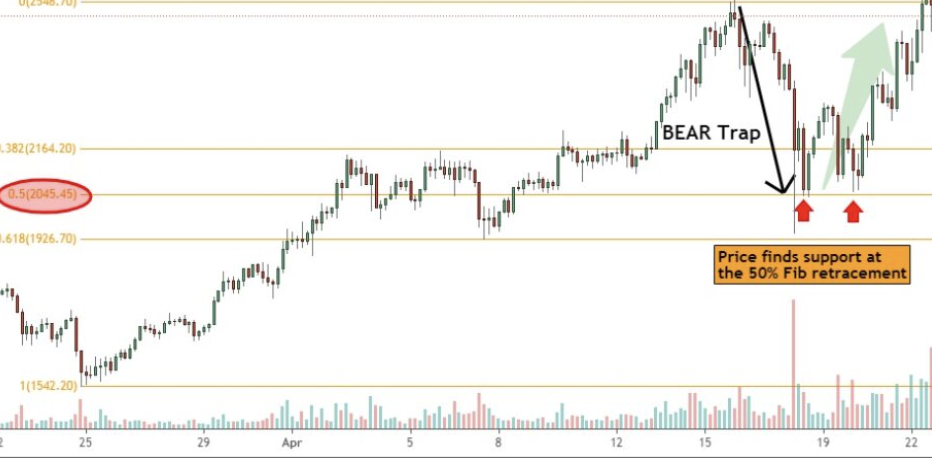
Drake Hampton
Mar 23, 2022 16:10
Stock market psychology is the capacity to recognize and manage the emotions and behaviors that may arise during trading. While the stock market is a forward-looking gauge of expectations for corporate profits performance, it is frequently influenced by variables affecting both individual and collective trading psychology.
Three criteria to consider are the following:
Investor sentiment
Sentiment in the market
Fear or greed are examples of emotions.
The purpose of this article is to demonstrate the critical nature of trading psychology in the stock market and to give further information and advice on how to handle it. Our guide to stock trading for beginners provides an overview of the stock market.

While the impact of psychology in the stock market is sometimes underestimated, being able to detect and handle these psychological elements may be tremendously useful for a trader. Individually, illogical financial decisions are frequently motivated by emotions such as anxiety, greed, and the fear of losing out (FOMO in trading). Crowd psychology, on the other hand, contributes to significant market fluctuations by eliciting emotions and resulting in fear-based trading.
A case in point of this is a worldwide pandemic. When fear levels rise, stock market volatility frequently follows. Volatility increases are typically followed by one of two emotions: fear or FOMO. Pessimism appears to exert a stronger influence on volatility than optimism. Fear frequently results in 'panic selling,' as traders hurry to quit deals in order to avoid more losses.
Market sentiment is an excellent indicator of volatility since it is used to determine how investors view a market at any particular time. When traders believe the market to be bearish, there will be more selling than buyers, implying a negative crowd psychology.
Stock indices are the most direct indication of audience psychology for equities. A stock index measures the performance of a group of stocks within a certain country or market. The major stock indexes are used to compare the returns on various assets and to follow the broader economy via the index's performance.
Once a trader has a firm grasp on both personal and group psychology, it is critical for the trader to control emotions appropriately. While some emotions should be welcomed, the negative impacts of trade psychology on investing decisions are often bigger than the favorable benefits of positive psychology.
Fear and greed may be detrimental to traders by pushing them to behave rashly. When a trader exits a position early, this is an example of fear-based trading. Dread may also manifest as greed when traders maintain losing positions for an extended length of time out of fear of incurring a loss.
To gain from stock market psychology, a trader must embrace good psychological variables while seeking to moderate negative psychological factors.
A trading strategy serves as a guide for traders throughout the trading process. It is a collection of rules that specifies the circumstances that must be satisfied before a trade is initiated, the markets on which the transaction should be executed, and when the trades should be exited. A trading strategy's objective is to guarantee that the trader remains accountable and adheres to the plan.
Having a trading strategy is one thing; adhering to it is quite another when deals go against you. Having a concise checklist on hand guarantees that the trader follows the trading plan's guidelines throughout the trading process.
As a trader, it is critical to evaluate your performance and discover areas for development. A diary is an excellent tool for this, since it enables a trader to keep track of all transactions and determine what worked and what didn't. Occasionally, a diary will reveal flaws in a trading plan or approach that must be corrected.
Building confidence may be challenging, especially during the early phases of a strategy's testing. Confidence is critical because it enables a trader to take measured risks and accept the consequences of those risks. This is because a confident trader is typically aware of their own trading psychology and has established strategies to handle it. One strategy to develop trading confidence while also learning about trading psychology is to trade on a demo account. The objective is to establish reasonable expectations and to use the demo account as though it were real money.
A trader cannot afford to overlook risk management. Calculating risk/reward ratios, using stop losses, and trading in small increments are all critical components of a sound risk management approach.
Trading psychology is universal in nature, encompassing all financial markets and instruments. Emotions will always play a role regardless of the instrument traded, which is why it is critical to have measures in place that keep you focused on your goals regardless of your emotions.

Mar 23, 2022 15:42

Mar 23, 2022 16:23